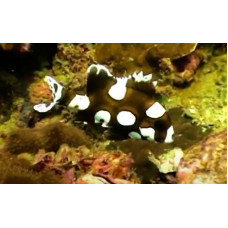Latin name
Plectorhinchus chaetodonoides
Other names
Clown sweetlips, spotted sweetlips, many-spotted sweetlips.
Identification
These fish have fleshy lips that swell moderately as the fish grows, the chin has 6 pores but no central fossa. The scales are ridged (rough to the touch). The lateral line of the tubular scales is about 52-59 mm. The depth of the body is 2.4-2.5 inches.
Features of fish fins
The dorsal fin usually has 12 spines, rarely 11, and 18-20 soft rays. The part of the dorsal fin with soft rays is about as high as the length of its base. The caudal fin of juveniles is deeply bifurcated and has broad, rounded lobes; adults have much less bifurcation. Anal spines: 3; Anal soft rays: 7-9.
Fish colouring
Juveniles are brownish with large, discrete creamy-white spots on the body that appear as the fish mature. As they mature, the coloration gradually becomes grayish with large dark brown spots that increase in iris diameter. The caudal fin blades of juveniles are white with a large brown spot.
Distribution
Widespread in the eastern Indian Ocean and western Pacific from the Maldives and Mauritius east to Tonga, north to the Ryukyu Islands and south to the Great Barrier Reef.
Habitat
Marine tropical species. Depths from 1 to 30 meters. Inhabit coral-rich parts of clear lagoons and coastal reefs.
Size
The maximum recorded total length is 72 cm (28 inches), although 60 cm (24 inches) is more typical, and the maximum published weight is 7 kg (15 pounds).
Behavior
Adults are solitary fish that live near ledges or caves during the day and hide underneath them. Juveniles hide in coral. Juveniles usually swim head down, flapping their fins vigorously as they swim, a behavior that may mimic poisonous or unpleasant tasting flatworms or cutworms and thus provide some protection from predators.
Food and feeding habits
It is a carnivorous species that preys on bottom-dwelling invertebrates such as crustaceans and mollusks, as well as fish, which it feeds on at night.
Reproduction
Egg-laying, clearly mating during reproduction.
Fishing
This species is not important to the local commercial fishery. The fish are caught with line and spear. Small colorful juveniles are collected for the aquarium trade.
Relationship with a person
The flesh of large individuals is described as "coarse and dry". This species is popular in aquariums.
| Classification | |
| Phylum | Chordata |
| Class | Actinopterygii |
| Squad | Perciformes |
| Family | Haemulidae |
| Genus | Plectorhinchus |
| Species | P. chaetodonoides |
| Features | |
| Conservation status | Not Evaluated |
| Habitat | Pelagic |
| Life span, years | No information |
| Maximum body weight, kg | 7 |
| Maximum length, cm | 60 |
| Sailing speed, m/s | No information |
| Threat to people | Edible |
| Way of eating | Predator |
Harlequin sweetlips
Tags: harlequin sweetlips



